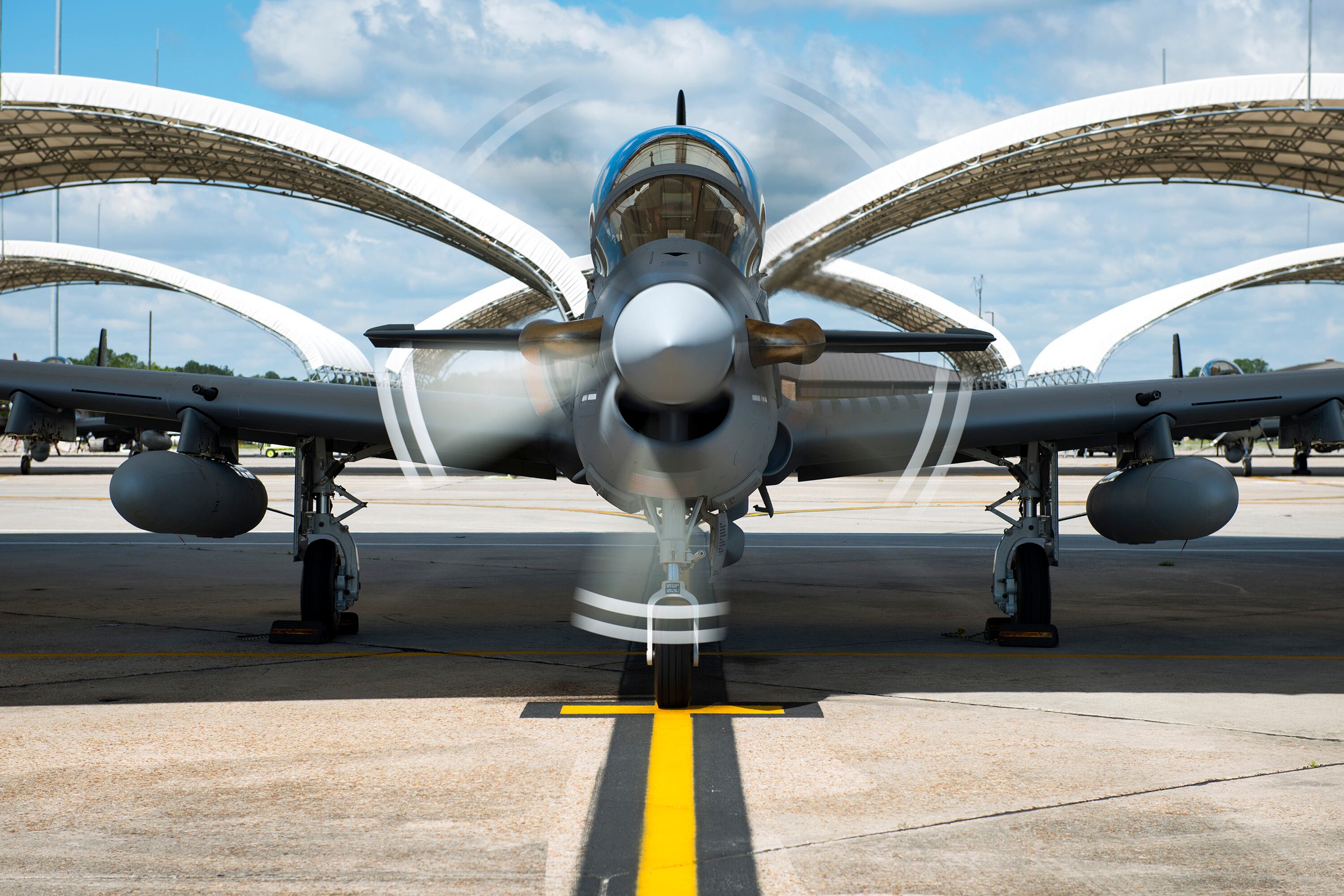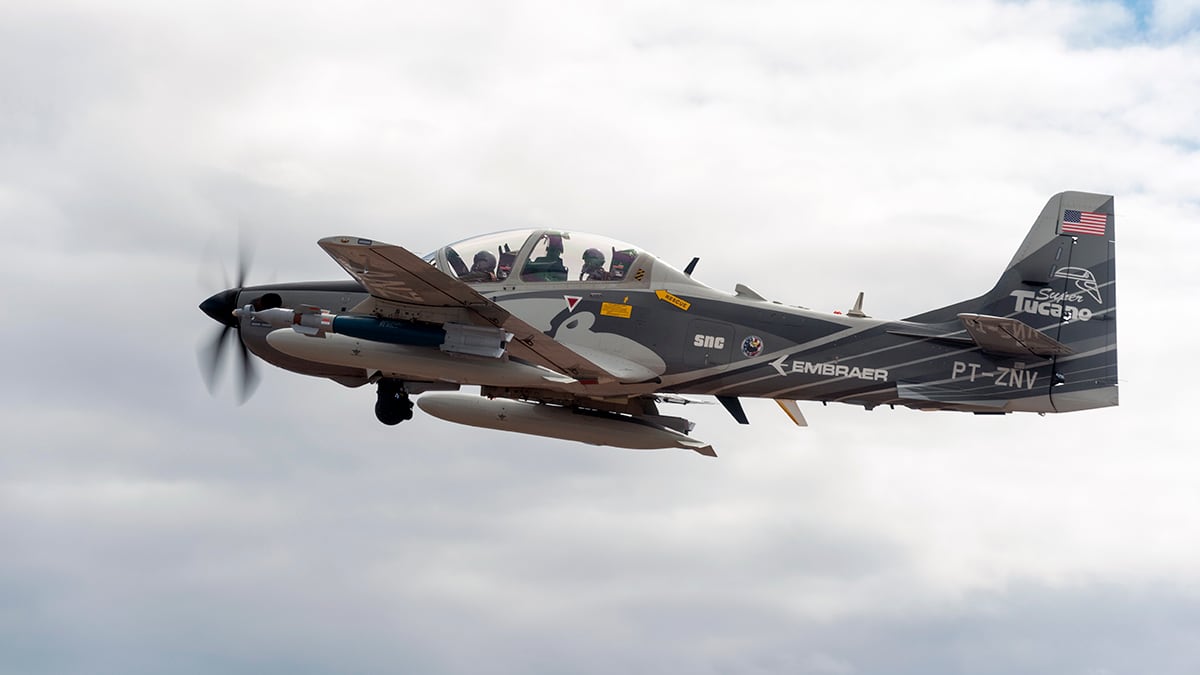The A-29 Super Tucano crash that killed a Navy aviator last summer at a New Mexico bombing range was caused when the pilot turned too sharply at a low airspeed after a weapon release and entered an uncontrollable dive.
Navy Lt. Christopher Short, an experienced F/A-18 pilot, was flying the Super Tucano at the Red Rio Bombing Range when he died June 22. He was tasking part in the second phase of the Air Force’s light-attack aircraft experiment. The range is part of the White Sands Missile Range north of Holloman Air Force Base.
The flight was proceeding normally until Short released his first weapon of the day, a 500-pound laser-guided GBU-12, from the left outboard pylon. He then tried to turn 180 degrees to the right, but the plane ended up rapidly rolling in that direction, and then entered into an uncontrolled spiral dive.
Short and his weapon systems officer tried four times to recover the aircraft and then attempted to eject. The WSO ejected at about 2,600 feet, five seconds before the plane hit the ground, and he survived with minor injuries.

But it was too late for Short. He pulled the ejection handle 3 to 3.5 seconds after his WSO — at about 700 feet, roughly 1.5 seconds before impact. Before he could eject, the plane hit the ground and he died on impact.
Accident investigation board president Brig. Gen. Kenneth Bibb concluded that the crash was caused by Short’s overcontrol of the plane, which inadvertently led to the spiral dive and failure to recover the aircraft.
An ‘aggressive’ maneuver
Bibb also found that Short made the wrong choice when he tried to pull off the 180-degree turn without compensating for the low-airspeed weapon release.
The report said Short and his WSO planned for the 180-degree turn in advance on the day of the mission, but the crew acknowledged in their pre-flight briefing that neither had performed that maneuver during their initial A-29 training.
The report said that other participants in the light-attack experiment had pulled off a similar 180-degree turn in another aircraft, the AT-6, eight days prior to the crash. That maneuver was “aggressive," that AT-6 crew said, and included more than 90 degrees of bank and more than 4 g-forces.
Representatives of the Sierra Nevada Corporation, which makes the Super Tucano, taught Short and his WSO to turn about 30 degrees, with 30 to 45 degrees of bank, after releasing a GBU-12.
The crew planned to use the momentum from dropping the left-hand GBU-12 as it rolled in the right direction, and the WSO expected to bank 30 to 45 degrees, but no more than 90 degrees.
RELATED

The A-29 took off a little after 11 a.m. At about 11:26 the aircrew climbed at 121 knots as they prepared for the weapon release — slower than the recommended climb speed of 145 knots. Short said he wanted to climb higher and try to pick up more airspeed before the release, but then said the crew “might have to accept being ‘kind of slow’ for this weapon release,” the report said.
The aural warning system sounded a “stall” warning with the A-29 at 124 knots. Short was cleared to drop the bomb and pushed the nose down to accelerate and complete the attack run. At that point, the Super Tucano was at 16,561 feet and 132 knots.
At 11:33, they dropped the bomb, and the plane rolled to the right as expected. However, the roll was exacerbated by 50 percent by the 1.47 g-forces they were experiencing.
The flight manual recommended countering such a right roll with the left aileron, the report said, but Short did the opposite. He applied the right aileron, while pulling the nose up and turning the right rudder. The plane then rolled rapidly to the right, quickly pitched nose down, and entered into a downward spiral, the report said.
The Super Tucano was flying at a far slower speed when it dropped the bomb than was recommended, the report said — 166 knots, or 44 knots below the target airspeed. Other A-29 crews aimed for release airspeeds of 200 to 210 knots, but typically no less than 180 knots. One air crew did pull off a 140-knot release but stuck to a 10- to 15-degree bank afterward.
Bibb also concluded that the crew’s delayed ejection sequence initiation — well below the recommended 5,000-foot level — specifically caused Short’s death.
The ejection seat was also set to single mode, requiring each crew member to pull his own ejection handle. Had the seat been set to aft mode, pulling one lever would have triggered both ejection seats (with the person in the rear seat ejecting first) and possibly saved Short’s life, the report said. The seats had been set to single because of a previous problem with the aft mode.
On July 3, the Air Force announced it would not conclude the flying portion of its light-attack experiment in the wake of Short's death, saying it had gathered enough flight test data from the A-29 and its competitor, Textron’s AT-6 Wolverine.
Then, on Jan. 18, the service announced that the experiment had been postponed for the foreseeable future as leaders decide the way forward.
Stephen Losey is the air warfare reporter for Defense News. He previously covered leadership and personnel issues at Air Force Times, and the Pentagon, special operations and air warfare at Military.com. He has traveled to the Middle East to cover U.S. Air Force operations.





